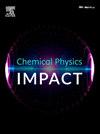Synthesis and luminescence properties of Na3SrB5O10:Eu3+ glass samples for solid-state lighting application
IF 4.3
Q2 CHEMISTRY, PHYSICAL
引用次数: 0
Abstract
Borate materials are very beneficial for optical materials due to its wide transparency range, huge electronic band gap, thermal and chemical durability, low preparative temperature, and high optical damage threshold. Na3SrB5O10 glasses were synthesized through a melt quenching technique followed by a sintering process, incorporating various concentrations of Eu3+ ions. The XRD pattern of the prepared glass sample indicates an amorphous pattern, vibrational feature of the prepared glass sample has been investigated using FT-IR analysis. Photoluminescence study of Eu3+ activated Na3SrB5O10 glass sample shows multiple emission peaks under NUV excitations in the red region. The prepared glass samples show orange-red emission bands at 595 nm and 615 nm, respectively, under the excitation of 395 nm and 465 nm. The red emission band is stronger than the orange emission band. The intense emission band was detected for doping of 2.5 mol% concentration of Eu3+ ions. In addition, CIE color coordinate, color purity and color correlated temperature (CCT) were determined using color calculator. The above results suggested that the Eu3+-activated Na3SrB5O10 glass samples have huge potential for lighting and display applications.

固态照明用Na3SrB5O10:Eu3+玻璃样品的合成及发光性能
硼酸盐材料具有透明范围宽、电子带隙大、耐热性和化学性好、制备温度低、光学损伤阈值高等优点,是非常有益的光学材料。Na3SrB5O10玻璃是通过熔体淬火技术和烧结工艺合成的,并加入不同浓度的Eu3+离子。制备的玻璃样品的XRD谱图显示为非晶谱图,并用FT-IR分析了制备的玻璃样品的振动特征。对Eu3+活化的Na3SrB5O10玻璃样品的光致发光研究表明,在紫外激发下,在红色区域有多个发射峰。在所制备的玻璃样品中,在395 nm和465 nm激发下,分别在595 nm和615 nm处呈现橙红色发射带。红色发射带比橙色发射带强。当掺入浓度为2.5 mol%的Eu3+离子时,检测到强发射带。此外,用颜色计算器测定CIE色坐标、色纯度和色相关温度(CCT)。上述结果表明,Eu3+活化的Na3SrB5O10玻璃样品在照明和显示应用方面具有巨大的潜力。
本文章由计算机程序翻译,如有差异,请以英文原文为准。
求助全文
约1分钟内获得全文
求助全文
来源期刊

Chemical Physics Impact
Materials Science-Materials Science (miscellaneous)
CiteScore
2.60
自引率
0.00%
发文量
65
审稿时长
46 days
 求助内容:
求助内容: 应助结果提醒方式:
应助结果提醒方式:


